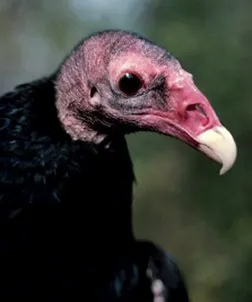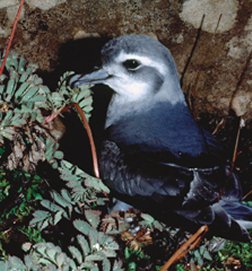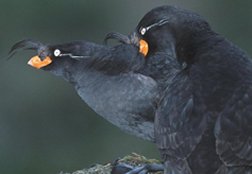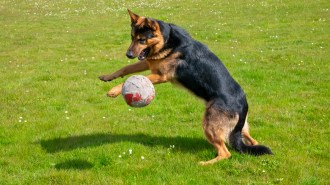Blame Audubon. Animal behaviorist Timothy Roper says that the renowned naturalist propagated die-hard misunderstandings of birds’ sense of smell. In 1826, he published on the habits of the turkey vulture “with a View to Exploding the Opinion Generally Held of Its Extraordinary Power of Smelling.” Observers as far back as Aristotle had claimed that various vultures sniff their way to prey. Yet Audubon argued that they couldn’t smell. He described hiding smelly meat close to caged turkey vultures. They showed no sign of noticing.



Many people today still think that birds don’t have working noses, and biologists often assume that the sense of smell doesn’t matter much in avian lifestyles, says Roper. Yet decades of studies have shown that birds do have a sense of smell, sometimes as fine as some mammals’. Turkey vultures, for example, can pick up faint traces of certain odors. A classic report in the 1960s noted that California-gas-company repair crews found leaks in their lines by watching for circling turkey vultures attracted to the carrionlike scent added to the gas as a safety alert.
During the past 2 decades, sophisticated tests have identified more and more avian species that use a sense of smell. Some follow their noses home. Others follow their noses to food when a landscape, such as open ocean, offers few other clues. An ongoing study is exploring whether birds communicate by scent, as mammals do.
So what did Audubon do wrong? A century and three-quarters is a bit late for second-guessing an experiment, but Roper, of the University of Sussex in England, questions the naturalist’s choice of meat. Vultures have standards, and the test meat may have smelled so bad that the birds weren’t any more interested in eating it than Audubon was.
Old nose-how
Since the early 19th century, other naturalists tested birds and agreed that they probably don’t have the sense of smell, says Roper. It’s an understandable point of view. Most birds just don’t seem as interested in smells as mammals are. Birds don’t go around “peeing on lampposts and sniffing each other’s rears,” he says. And many do seem to rely on sight for hunting food.
The subtle olfactory behavior in many bird species led to a paradox, according to Roper. Despite the scarcity of behavior suggesting that birds can detect smells, morphologists during the 20th century found that birds had the right equipment to do so.
The pair of holes typically located toward the upper end of a bird’s beak is, in fact, the avian version of nostrils. In pelicans, the holes are tiny, and a flap of skin shuts out water during dives. The air holes of kiwis, however, lie at the tips of their beaks and produce little sniffling noises as the kiwis hunt along the ground for food.
The rest of a bird’s smelling equipment is typical of that in any other vertebrate. Air enters the holes and moves through a series of chambers. A bird’s lungs draw much of the air downward, but some passes into a side chamber in the head. Receptors in an inner chamber’s lining send signals via olfactory nerves to a part of the brain called the olfactory bulb.
During the middle of the past century, several researchers compared olfactory bulb sizes of different animal species as a way of gauging how much smell matters to the individual. Turkey vultures, a group of seabirds called tubenoses, and kiwis tend to devote a relatively large proportion of their brains to olfactory processing.
These birds have attracted interest from behavioral scientists, and in the past several decades, experiments have demonstrated how certain citizens of the bird world put their olfactory equipment to use.
Way to go
Interest in how homing pigeons find their way kick-started the new era of behavioral research on smell, says Roper.
The first major experiments on sniff navigation came from the lab of Floriano Papi in Italy during the early 1970s. He proposed that pigeons memorize patterns of odors in the wind—a pine-forest tang here, a seashore saltiness there. In otherwise unfamiliar landscapes, he suggested, the birds use their memories of these odors much as a person uses a map.
When Papi and his colleagues sabotaged pigeon noses in various ways, they found that the birds were less likely than unimpaired pigeons to find their way home from an unfamiliar place. As human navigators do, various bird species may also orient themselves by some kind of compass, perhaps the sun, Earth’s magnetic field, or the stars. Yet even a navigator with a compass needs to know which direction is the right one.
The idea that birds can inhale a map was “unexpected,” admits olfactory-navigation researcher Hans Wallraff of the Max Planck Research Center for Ornithology in Seewiesen, Germany. And he acknowledges that the idea remains controversial. Yet evidence from pigeons released in Morocco, the United States, Brazil, Germany, and England support the idea, he noted in the February 2004 Animal Behaviour.
Scientists have also tested a few other types of birds that home, he says. Smell sabotage has confused swifts. And European starlings released far from home can’t find their way back if they can’t smell anything.
Last winter, a team of behavioral scientists raised an objection to that line of research. An old alternative hypothesis to odor maps proposes that birds work their way along Earth’s magnetic field. In the Nov. 25, 2004 Nature, Cordula V. Mora of the University of North Carolina at Chapel Hill and her colleagues presented evidence that a pigeon detects Earth’s magnetic field with part of its beak. The researchers say that their experiments show that standard ways of blocking the pigeon’s sense of smell by tampering with its upper beak accidentally scrambles the magnetic sense, too.
However, another approach to scent research dating to the 1970s avoids blocking the nose. Instead, scientists sabotage the wind. In one test, Papi and his collaborators raised pigeons in corridors where fans reversed the direction of natural air currents. When released in a strange place, these birds flew in the opposite direction from home.
In another test, researchers blocked the wind from one direction so that young pigeons growing up wouldn’t smell its typical odors. When the pigeons were set loose in the zone they hadn’t been able to smell, they ended up flying in random directions.
Roper says that investigators still need to show that drifting odor plumes could really make a map. He also points out that in tests, some of the smell-impaired birds typically get home, regardless of their handicap. The question of how pigeons may combine smell with other navigational tools is “still wide open,” he says.
Not lost at sea
One open expanse of water may look much like another, but oddly enough, expanses of water don’t always smell the same.
A family of seabird species called tubenoses, including big creatures such as albatrosses as well as small ones such as petrels, ranked high when scientists compared brain space devoted to smell. The birds’ name comes from nasal passageways that lie on their beaks like drinking straws.
Studies of some tubenose colonies in the 1970s revealed that birds fly upwind as they approach their home colonies. Once they arrive, they tend to walk toward their burrows upwind. Could the birds be smelling their way home?
For at least some of the smaller tubenoses, experiments indicate that smell matters, says Francesco Bonadonna of the National Center of Scientific Research (CNRS) in Montpellier, France. These species typically slip back to their burrows at night, lowering the risk of attacks from predators. In the dark, the birds might have to sniff out their route.
Bonadonna and his colleagues have examined a variety of tubenose birds, including thin-billed prions and Wilson’s storm petrels. The team tampered with the birds’ sense of smell by either temporarily plugging their nostrils with window putty or chemically disabling their smell sensors. For several nights after the tampering, impaired birds of these two species were less likely to find their burrows than were colony mates with unplugged noses.
Yet other tubenose species didn’t get disoriented when researchers blocked their noses. These species tend to be bigger and tougher than the prions and petrels, says Bonadonna. They come home in broad daylight with less risk of attack.
For short-range navigation in species such as the blue petrel, a bird can distinguish by smell its own burrow from that of another bird of the same species, says Bonadonna. He and his colleagues demonstrated this by observing whether a bird chose a passageway attached to either its home burrow or a neighbor’s. The birds usually chose the right way home, except when the scientists blocked burrow smells from entering the passageways, they report in the May 2004 Animal Behaviour.
Tubenoses may employ their olfactory sense for more than homing. For years, researchers have mused about whether those birds find prey at sea by catching its scent. Papers published as early as the 1940s report intriguing observations, for instance, that a sea bird called a fulmar passing downwind of floating pork fat worked its way toward the slick by zigzagging back and forth across the wind.
By the early 1990s, researchers had tested birds’ reactions to many fish and krill odors, says Gabrielle Nevitt of the University of California, Davis. A variety of birds did show interest in slicks of such smelly items as cod liver oil, but there were some puzzling lacks of response too. For example, certain petrels that eat much krill didn’t show interest in slicks of vegetable oil laced with krill puree.
During a research cruise to the Antarctic, stormy seas threw Nevitt against a tool cabinet. Confined to her bunk to recuperate from her injury, she realized she could easily smell the dimethyl sulfide (DMS) that an atmospheric chemist on board was using for experiments.
If she could smell it, perhaps the birds could, Nevitt thought. And it might make a great clue for finding good dining spots at sea. DMS wafts into the atmosphere in heightened concentrations when the microscopic zooplankton in seawater graze on photosynthetic phytoplankton. Seabirds don’t eat plankton, but krill do. Thus, Nevitt wondered, would seabirds regard dimethyl sulfide as an invitation to an upcoming krill feast?
Tests with slicks of concentrated DMS proved Nevitt’s hunch correct. A variety of species such as blue petrels and prions responded. More-recent trials have shown that Antarctic prions can detect DMS at concentrations that they’d encounter while flying over the ocean, Nevitt and Bonadonna report in the Sept. 29 Biology Letters.
Also, these birds typically walked toward DMS when offered a choice of different scents in a box with branched passageways.
Atmospheric chemists have found several zones of high and low DMS concentrations over the Indian Ocean. That makes sense, Nevitt says, because seamounts and clashes of ocean currents create relatively predictable upwellings where plankton can flourish in the chilly, nutrient-rich water.
Birds detecting DMS peaks and valleys could in theory navigate by them, proposes Nevitt.
You smell
“I got to hold a kakapo,” says Julie Hagelin of Swarthmore (Pa.) College. “This was a life-changing experience.”
A kakapo is a flightless parrot that roots around as a chicken does—a nocturnal chicken. The small population of kakapos remaining in the wild lives on a protected island in New Zealand. Since an adult kakapo weighs some 8 pounds, changing a battery in a kakapo radio collar takes four hands. Hagelin first encountered one of the birds when she volunteered to help with that task.
“The first thing I noticed was this really remarkable odor that was coming from the bird,” she says. Some people have described it as smelling like an old clarinet case, she remembers, but she found it sweeter, a mix of herbs and honey.
That kakapo inspired Hagelin to open a new frontier in the study of bird odors: olfactory communication. Combing through the literature, she’s found that ornithologists have reported natural odors for 177 avian species.
The feathers of the crested auklet, for example, smell like tangerines, Hagelin says. Her studies in auklet colonies in Alaska suggest that the tangerine scent intensifies during breeding season. That fits nicely with Hagelin’s observations that courting auklets poke their beaks into the ruffs around each other’s necks. Also, Hagelin and her colleagues have found that the birds prefer two odor components of the feather scent to odors such as that of bananas.
Birds don’t seem to have much in the way of scent-secreting glands, but Hagelin says that they may not need them. At the meeting of the American Society for Microbiology in June in Atlanta, her research team proposed that the tangerine scent comes from bacteria colonizing the birds.
Scent communication might last beyond courtship. In the first demonstration of a bird recognizing its lifelong mate by scent, Bonadonna and Nevitt reported in the Oct. 29, 2004 Science that prions can repeatedly distinguish the odor of their mates from that of other birds.
While most studies of bird scent accentuate the positive, Roper has found that chickens, at least, have a strongly negative reaction to certain odors. Chickens avoid the scent of ammonia, which in fact abounds in industrial poultry operations. He says that he hopes researchers will find ways to improve the welfare of chickens with fresher air.
Bird olfaction might prove the key to the tricky problem of repelling avian pests, such as starlings that raid animal feed on farms. Arla Hile at Monell Chemical Senses Center in Philadelphia has found that garlic and a group of chemicals called citronellyls turn away some of the birds.
Roper says that what’s really needed now are detailed studies of birds’ sensitivities to different odors. He’s planning a symposium on bird smell next year. There, he says, he hopes to convince more scientists to wake up and smell the feathers.






